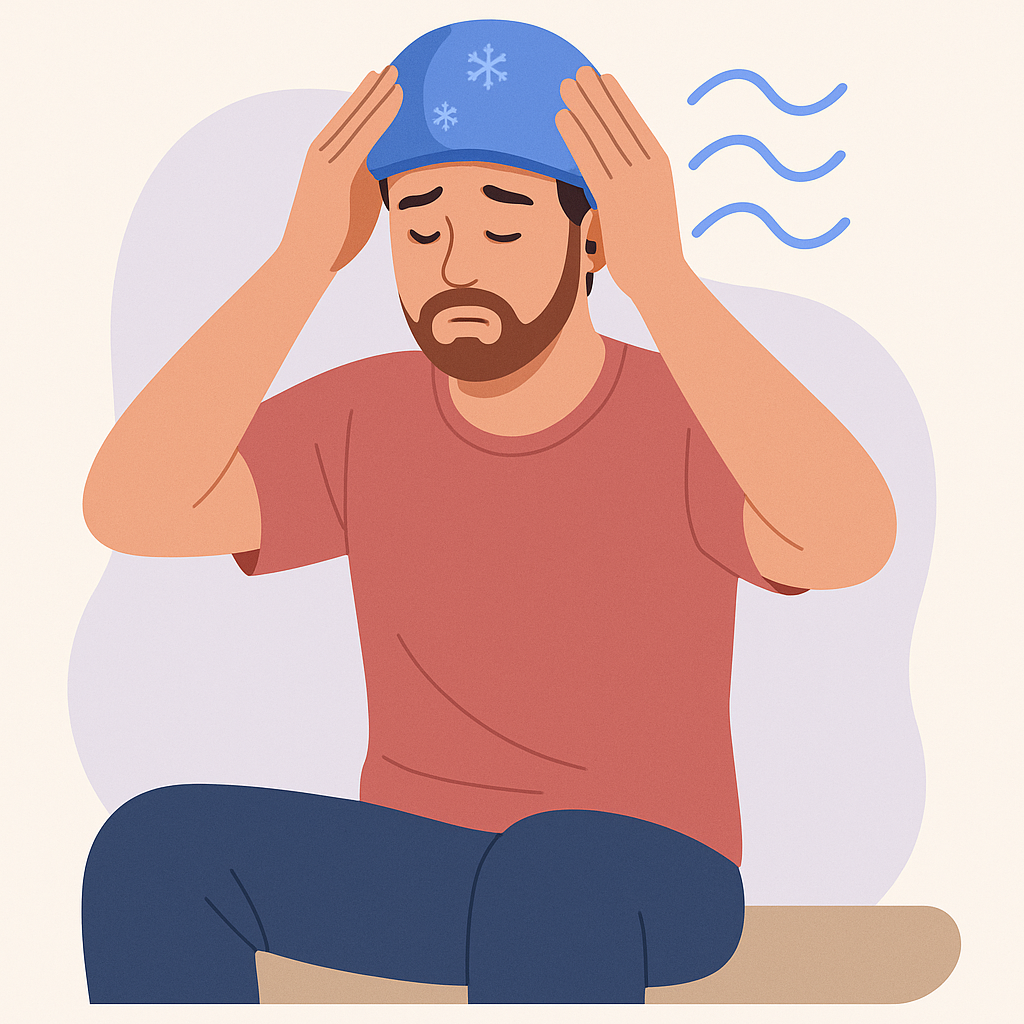Migraines can be exhausting, often striking without warning and leaving you desperate for quick relief. While medication can help, many people are now turning to natural, drug-free methods like cold therapy to ease the pain. Among these, the cold cap for migraines has become one of the most effective and accessible solutions.
But how do you use a cold cap correctly to get the best results? In this article, we’ll explain how to use a cold cap for migraines safely and effectively, when to apply it, and how this simple tool can provide soothing comfort and faster recovery during painful migraine episodes.
What are the steps for using a cooling cap to relieve migraines?
A cooling cap, also known as an ice cap or migraine relief cap, is one of the most effective natural tools for easing migraine pain. It combines the power of cold therapy with light compression to calm nerve activity, reduce inflammation, and relieve tension in the head and neck. However, to get the best results, it’s essential to know how to use it properly. Following the right steps ensures maximum comfort, safety, and fast relief.
Here’s a step-by-step guide to using a cooling cap for migraines safely and effectively.
Step 1: Prepare your cooling cap
Before your next migraine attack, make sure your cooling cap is ready to use. Most migraine caps contain medical-grade gel or gel beads that can be chilled in the refrigerator or freezer. To prepare:
-
For mild cooling, place it in the refrigerator for about 1 hour.
-
For deep cooling, leave it in the freezer for 2–3 hours.
Ensure the cap is not frozen solid it should remain soft and flexible so it can adapt comfortably to your head’s shape. This flexibility ensures even cooling across all key areas, including the forehead, temples, and back of the neck.
If your cap feels too cold, let it sit at room temperature for a few minutes before applying it to avoid skin irritation.
Step 2: Find a calm environment
Migraines are often triggered or worsened by sensory stimuli such as light, noise, or stress. Before applying your cooling cap, move to a quiet, dark room where you can relax. Sit or lie down in a comfortable position and take a few deep breaths to ease tension.
Using the cap in a calm setting enhances its soothing effect. It helps your nervous system slow down, allowing the cold therapy to work more efficiently.
Step 3: Apply the cap correctly
Once the cooling cap is ready, gently place it over your head. Adjust it so it covers all key migraine trigger zones:
-
The forehead and temples, where blood vessels often dilate during a migraine.
-
The back of the neck, which contains the occipital nerves linked to head pain.
-
The crown of the head, to evenly distribute the cooling sensation.
Make sure the cap fits snugly but not tightly. The goal is gentle compression, not restriction. The light pressure enhances blood vessel constriction and adds a calming, massaging sensation that further eases discomfort.
Step 4: Keep it on for the right amount of time
Cold therapy works best in moderation. Leave the cooling cap on for 15 to 20 minutes per session. This is usually enough to reduce inflammation and numb pain without causing skin irritation or discomfort.
If you still feel pain after the session, take a short break of 30 minutes, then reapply the cap if needed. You can repeat this process several times throughout the day during a migraine attack.
Avoid wearing the cap for longer than 30 minutes at once, as overexposure to cold can cause mild headaches or skin redness.
Step 5: Combine with relaxation techniques
To enhance the effects of cold therapy, pair your cooling cap session with simple relaxation practices such as:
-
Deep, slow breathing to calm the nervous system.
-
Gentle neck and shoulder stretches to release tension.
-
Closing your eyes and visualising calm, soothing imagery.
These small habits work alongside the cooling effect to further relieve stress and reduce migraine duration.
Step 6: Clean and store properly after use
Once you’ve finished, remove the cap and gently wipe it with a clean cloth or wash it with mild soap and water if it’s washable. Always let it air dry completely before putting it back in the freezer.
Keeping your cooling cap clean prevents bacteria build-up and prolongs its lifespan. If you experience frequent migraines, consider owning two caps so one can chill while the other is ready for immediate use.
Step 7: Use it at the first sign of symptoms
For best results, use your cooling cap as soon as you notice early migraine warning signs such as light sensitivity, nausea, or eye strain. Applying cold therapy during the early stages can help stop the attack before it escalates.
If you suffer from frequent migraines, keeping your cap in the freezer ensures it’s always ready when you need it most.
How to use a cold cap for migraines safely and effectively?
Using a cold cap for migraines can be one of the simplest, safest, and most effective natural methods to relieve pain. Cold therapy has been used for centuries to reduce inflammation, numb pain, and relax muscles. Modern migraine cold caps take this principle further by offering full-head coverage and ergonomic comfort. However, to make the most of your cold cap and to ensure it remains completely safe it’s essential to follow a few key guidelines.
Here’s how to use a cold cap for migraines both safely and effectively, step by step.
Prepare the cold cap correctly
The first step is to chill your cap to the right temperature. Most migraine caps contain a soft gel that should be stored either in the refrigerator or the freezer, depending on your sensitivity.
-
For gentle cooling, keep it in the fridge for about one hour.
-
For deeper cold therapy, place it in the freezer for two to three hours.
When properly chilled, the cap should feel cold but flexible — not rock-hard. If it becomes too stiff, let it sit at room temperature for a few minutes before applying. This prevents skin irritation and ensures an even, comfortable fit around your head.
Never apply a cap that’s frozen solid directly to your skin, as extreme cold can cause mild burns or frostbite.
Apply at the right time
Timing plays a major role in how well your cold cap works. For best results, apply it at the first signs of a migraine attack — also known as the prodrome phase. During this stage, you may feel symptoms such as light sensitivity, nausea, or pressure in the head.
Using the cold cap early helps reduce blood vessel dilation and calm nerve activity before the pain intensifies. If your migraine is already in full force, the cap can still help, but early intervention usually brings faster relief.
You can also use it after the attack, during the postdrome phase, to help your body recover and relieve lingering tension.
Use in a quiet, comfortable environment
To maximise the soothing effects, use your cold cap in a dark, quiet room away from screens and noise. This helps your body relax while the cold therapy reduces inflammation and pain.
Lie down or recline in a comfortable position, take slow breaths, and let the cooling effect work. Combining your cold cap with relaxation techniques like deep breathing or meditation can make the experience even more effective.
Adjust and wear properly
When putting on your cold cap, make sure it covers the key migraine pain zones:
-
The forehead and temples to ease throbbing pain.
-
The back of the neck to relax the occipital nerves.
-
The crown of the head for full coverage and balance.
Most high-quality caps, such as the Sameo™ Migraine Relief Ice Cap, are designed for 360° cooling coverage. They provide gentle compression without feeling tight or uncomfortable. This light pressure enhances blood flow regulation and adds a calming, massaging sensation that many users find soothing.
Make sure the cap fits snugly but not too tight. Over-compression can restrict circulation and cause discomfort.
Limit the duration
Cold therapy should always be used in moderation. Keep your cold cap on for 15 to 20 minutes at a time, then remove it for a short break. You can reapply it later in the day if necessary, but avoid wearing it for more than 30 minutes continuously.
Overexposure to cold may cause temporary redness, numbness, or a burning sensation. Giving your skin time to return to its normal temperature helps prevent irritation and ensures long-term safety.
Maintain hygiene and care
After each use, clean your cold cap to prevent bacteria or odour build-up. If your cap is washable, rinse it with mild soap and water, then let it air dry completely before storing it in the freezer again.
If you use the cap frequently, consider having two caps so that one is always ready while the other dries. Proper maintenance extends its lifespan and keeps it hygienic for everyday use.
Know when to avoid using a cold cap
Although cold caps are safe for most people, a few precautions apply. Avoid using one if you have:
-
Circulatory problems (such as Raynaud’s syndrome).
-
Skin sensitivity or open wounds on the scalp.
-
Severe diabetic neuropathy or conditions that reduce temperature sensitivity.
If you experience any unusual discomfort, remove the cap immediately and allow your skin to warm up naturally.
Can you sleep while wearing a cold cap for migraines?
Sleeping while wearing a cold cap for migraines might seem like a good idea especially if you’re hoping to soothe pain through the night. However, experts generally do not recommend sleeping with a cold cap on. While cold therapy is highly effective for migraine relief, using it for too long or without supervision can cause discomfort or mild side effects such as skin irritation or numbness.
Cold caps work by constricting blood vessels and calming nerve activity, helping reduce inflammation and pain. This process is most effective within 15 to 30 minutes of use. After that, the benefits tend to diminish, and prolonged exposure to cold can become counterproductive. If worn overnight, the cap could lower the skin temperature excessively, leading to redness, stiffness, or even a mild cold burn in sensitive individuals.
That said, short cooling sessions before bedtime can be an excellent way to relax and reduce pain enough to fall asleep more easily. Applying the cold cap for 20 minutes while lying in a quiet, dark room can help the body unwind and prepare for rest. Once the cooling session ends, remove the cap and allow your skin to warm up naturally before going to sleep.
If migraines frequently disrupt your sleep, it may be worth creating a bedtime migraine relief routine that combines the cold cap with relaxation techniques such as gentle breathing, stretching, or aromatherapy. This helps lower stress levels, which are a common migraine trigger.
For those who need consistent cooling throughout the night, a reusable gel pack or pillow designed for sleep-safe cold therapy may be a better alternative, as they provide mild cooling without direct contact or compression.
In summary, you should not sleep while wearing a migraine cold cap. Instead, use it for controlled, short sessions before bed to enjoy safe, soothing, and effective migraine relief that helps you drift off comfortably.



Is it good to put ice on a migraine?
How long to freeze a migraine cap?